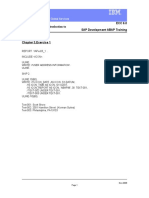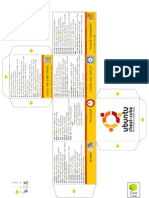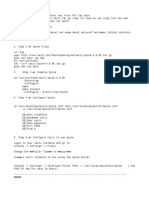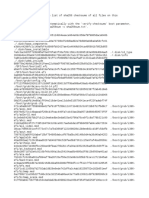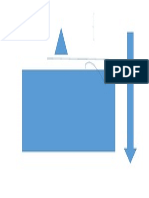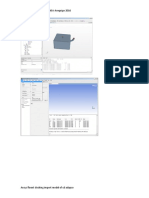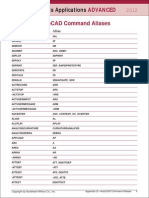Ubuntu Command Reference Cheat Sheet
Uploaded by
v155rUbuntu Command Reference Cheat Sheet
Uploaded by
v155rUbuntu Reference
Privileges Network
sudo command – run command as root ifconfig – show network information
sudo -s – open a root shell iwconfig – show wireless information
sudo -s -u user – open a shell as user sudo iwlist scan – scan for wireless networks
sudo -k – forget sudo passwords sudo /etc/init.d/networking restart – reset
gksudo command – visual sudo dialog (GNOME) network for manual configurations
kdesudo command – visual sudo dialog (KDE) (file) /etc/network/interfaces – manual
sudo visudo – edit /etc/sudoers configuration
gksudo nautilus – root file manager (GNOME) ifup interface – bring interface online
kdesudo konqueror – root file manager (KDE) ifdown interface – disable interface
passwd – change your password
Special Packages
Display ubuntu-desktop – standard Ubuntu environment
sudo /etc/init.d/gdm restart – restart X and kubuntu-desktop – KDE desktop
return to login (GNOME) xubuntu-desktop – XFCE desktop
sudo /etc/init.d/kdm restart – restart X and ubuntu-minimal – core Ubuntu utilities
return to login (KDE) ubuntu-standard – standard Ubuntu utilities
(file) /etc/X11/xorg.conf – display ubuntu-restricted-extras – non-free, but useful
configuration kubuntu-restricted-extras – KDE of the above
sudo dexconf – reset xorg.conf configuration xubuntu-restricted-extras – XFCE of the above
Ctrl+Alt+Bksp – restart X display if frozen build-essential – packages used to compile
Ctrl+Alt+FN – switch to tty N programs
Ctrl+Alt+F7 – switch back to X display linux-image-generic – latest generic kernel
image
System Services¹ linux-headers-generic – latest build headers
start service – start job service (Upstart)
stop service – stop job service (Upstart) Firewall¹
status service – check if service is running ufw enable – turn on the firewall
(Upstart) ufw disable – turn off the firewall
/etc/init.d/service start – start service ufw default allow – allow all connections by
(SysV) default
/etc/init.d/service stop – stop service (SysV) ufw default deny – drop all connections by
/etc/init.d/service status – check service default
(SysV) ufw status – current status and rules
/etc/init.d/service restart – restart service ufw allow port – allow traffic on port
(SysV) ufw deny port – block port
runlevel – get current runlevel ufw deny from ip – block ip adress
Package Management¹ Application Names
apt-get update – refresh available updates nautilus – file manager (GNOME)
apt-get upgrade – upgrade all packages dolphin – file manager (KDE)
apt-get dist-upgrade – upgrade with package konqueror – web browser (KDE)
replacements; upgrade Ubuntu version kate – text editor (KDE)
apt-get install pkg – install pkg gedit – text editor (GNOME)
apt-get purge pkg – uninstall pkg
apt-get autoremove – remove obsolete packages System
apt-get -f install – try to fix broken packages Recovery - Type the phrase “REISUB” while
dpkg --configure -a – try to fix broken holding down Alt and SysRq (PrintScrn) with
packages about 1 second between each letter. Your system
dpkg -i pkg.deb – install file pkg.deb will reboot.
(file) /etc/apt/sources.list – APT repository lsb_release -a – get Ubuntu version
list uname -r – get kernel version
uname -a – get all kernel information
1. Prefix commands with sudo to run.
Ubuntu is a trademark of Canonical Ltd. Licensed under CC-BY-SA 3.0. Free to redistribute; see creativecommons.org for details.
You might also like
- Learn PowerShell in a Month of Lunches, Fourth Edition: Covers Windows, Linux, and macOSFrom EverandLearn PowerShell in a Month of Lunches, Fourth Edition: Covers Windows, Linux, and macOS5/5 (1)
- Learning Proxmox VE: Unleash the power of Proxmox VE by setting up a dedicated virtual environment to serve both containers and virtual machinesFrom EverandLearning Proxmox VE: Unleash the power of Proxmox VE by setting up a dedicated virtual environment to serve both containers and virtual machinesNo ratings yet
- Powershell: The ultimate beginner's guide to Powershell, making you a master at Windows Powershell command line fast!From EverandPowershell: The ultimate beginner's guide to Powershell, making you a master at Windows Powershell command line fast!5/5 (1)
- Linux for Beginners: Linux Command Line, Linux Programming and Linux Operating SystemFrom EverandLinux for Beginners: Linux Command Line, Linux Programming and Linux Operating System4.5/5 (3)
- Configuration of a Simple Samba File Server, Quota and Schedule BackupFrom EverandConfiguration of a Simple Samba File Server, Quota and Schedule BackupNo ratings yet
- Linux Fundamentals A Practical Guide To Learning Linux100% (7)Linux Fundamentals A Practical Guide To Learning Linux200 pages
- LINUX Administrator's Quick Reference Card: User Management NFS File Sharing100% (3)LINUX Administrator's Quick Reference Card: User Management NFS File Sharing6 pages
- Over 5 Hours: Ubuntu Linux Mint Elementary Tails67% (3)Over 5 Hours: Ubuntu Linux Mint Elementary Tails10 pages
- Work with the Command-line: To Manage Files and Directories in UbuntuFrom EverandWork with the Command-line: To Manage Files and Directories in Ubuntu5/5 (4)
- How to Switch from Windows to Linux at Home without Fear of Change, Aimed at Users with No Experience in Linux and with Amazing ResultsFrom EverandHow to Switch from Windows to Linux at Home without Fear of Change, Aimed at Users with No Experience in Linux and with Amazing ResultsNo ratings yet
- Linux: A complete guide to Linux command line for beginners, and how to get started with the Linux operating system!From EverandLinux: A complete guide to Linux command line for beginners, and how to get started with the Linux operating system!No ratings yet
- LINUX: Beginner's Crash Course. Your Step-By-Step Guide To Learning The Linux Operating System And Command Line Easy & Fast!From EverandLINUX: Beginner's Crash Course. Your Step-By-Step Guide To Learning The Linux Operating System And Command Line Easy & Fast!3.5/5 (3)
- VMware - A Guide for New Admins - CLI: VMware Admin Series, #2From EverandVMware - A Guide for New Admins - CLI: VMware Admin Series, #2No ratings yet
- Linux: A Comprehensive Guide to Linux Operating System and Command LineFrom EverandLinux: A Comprehensive Guide to Linux Operating System and Command LineNo ratings yet
- RHCSA Exam Pass: Red Hat Certified System Administrator Study GuideFrom EverandRHCSA Exam Pass: Red Hat Certified System Administrator Study GuideNo ratings yet
- LINUX Beginner's Crash Course: Linux for Beginner's Guide to Linux Command Line, Linux System & Linux CommandsFrom EverandLINUX Beginner's Crash Course: Linux for Beginner's Guide to Linux Command Line, Linux System & Linux Commands4/5 (1)
- LPI Linux Certification Questions: LPI Linux Interview Questions, Answers, and ExplanationsFrom EverandLPI Linux Certification Questions: LPI Linux Interview Questions, Answers, and Explanations3.5/5 (6)
- CentOS 8 Essentials: Learn to Install, Administer and Deploy CentOS 8 SystemsFrom EverandCentOS 8 Essentials: Learn to Install, Administer and Deploy CentOS 8 SystemsNo ratings yet
- An Autobiography or The Story of My Experiments With Truth100% (12)An Autobiography or The Story of My Experiments With Truth269 pages
- Lab Manual Unix and Linux Programming PR Cot 218 and It 214No ratings yetLab Manual Unix and Linux Programming PR Cot 218 and It 2147 pages
- Steps in Installation of ns3 in Ubuntu 16.04LTS: Apt-Get Install GDB ValgrindNo ratings yetSteps in Installation of ns3 in Ubuntu 16.04LTS: Apt-Get Install GDB Valgrind2 pages
- Linux - Get Specific Line From Text File Using Just Shell Script - Stack OverflowNo ratings yetLinux - Get Specific Line From Text File Using Just Shell Script - Stack Overflow6 pages
- GCC vs. Clang and How To Use Bits:stdc++ Header in MacOS - Saadnoor Salehin Shwapneel PDFNo ratings yetGCC vs. Clang and How To Use Bits:stdc++ Header in MacOS - Saadnoor Salehin Shwapneel PDF5 pages
- Desktop Documents Downloads Music Pictures Public Templates VideosNo ratings yetDesktop Documents Downloads Music Pictures Public Templates Videos22 pages
- Tutorial Sloshing CD Adapco Import Ansys FluentNo ratings yetTutorial Sloshing CD Adapco Import Ansys Fluent55 pages
- Install & Configuration Web Server PHP 5.6 For "Laravel Framework" in System Operation Centos 7No ratings yetInstall & Configuration Web Server PHP 5.6 For "Laravel Framework" in System Operation Centos 74 pages










